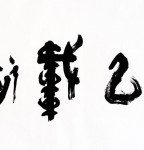Brush | Ink Stick | Paper | Ink Slab Or Ink Stone | Seal
What Chinese calligraphy supply do you need? To write Chinese characters, you need a brush, ink, paper and ink stone, commonly referred to as the four treasures of the study. In order to learn calligraphy, it is necessary to learn about these tools, select them carefully and take care of them. As the saying goes, one must temper the means to achieve the end. This is by virtue of necessity.
Among the various tools of calligraphy, writing brush is peculiar to China. The brushes are varied, and white goat's hair, black rabbit's hair and yellow weasel's hair are three major types. On the basis of the function of tip, the brushes are classified into three groups: "Hard", "Soft" and "Both". The handle is made of not only bamboo, wood, lacquer and porcelain, but also some precious materials including mother-of-pearl inlay, ivory and jade.
Writing brush has such a long history that prehistoric painted pottery, inscriptions on oracle bones, bamboo slips and silks are all writing materials for brush. Some ancient writing brushes were also excavated in the graves of the Spring and Autumn Period, the Warring States, the Qin and Han Dynasties. In the Tang and Song Dynasties, Xuanzhou became the national writing-brush-producing center, whose products were called "Xuan-bi", and "Zhuge-bi" was the best in quality in Xuanzhou. After the Yuan Dynasty the brush-producing industry of Huzhou boomed, and "Hu-bi" replaced "Xuan-bi". The characteristics of "Hu-bi" were sharp, neat, round and tough.Read more information about brush.
The ink-stick is the unique pigment of Chinese traditional painting and calligraphy. At the initial stage natural ink or half-natural ink was generally used. It was during the Han that artificial ink appeared. At that time the most famous ink-stick was "Yumi-mo" produced at Qianyang, Shaanxi. The raw materials of ink-stick were pine, oil and lacquer.
Before the Five Dynasties the ink-producing center was in the North, then it reached the South. The most celebrated South ink-stick was "Hui-mo", which was produced in Huizhou of Anhui. Read more information about ink-stick.
Paper is one of the most famous Chinese inventions. It is widely accepted that paper was invented by Cai Lun in the Eastern Han. However the archaeologists have discovered paper of Western Han such as "Fang-ma-tan" paper, "Ba-quao" paper, "Xuan-quan" paper, "Ma-quan-wan" paper, "Ju-yan" paper and "Han-tan-po" paper.
After the Eastern Jin Dynasty, paper was extensively used instead of traditional writing materials such as bamboo slips and silks. Various methods of producing paper emerged one after another. Read more information about paper.
In the Tang and Song Dynasties, the paper producing industry was very thriving. Celebrated products in best quality appeared one after another. In the Qing "Xuan-zhi" produced in Jing Prefecture of Anhui (Xuanzhou), became the special paper for painting and calligraphy, and was regarded as "the king of the paper"
Inkstone is the most important of "four treasures of the study". Because of its solid texture inkstone can be handed down from ancient times.
In the ruins of primitive society the archaeologists discovered simple stone ink-slab that needed a pestle to grind pigments. After artificial ink-sticks appeared in Han, pestle gradually disappeared. There were pottery ink-slab, lacquer ink-slab and copper ink-slab in the Han Dynasty as well as stone ink-slab. Among the stone ink-slabs, the round tripod pieces were the most typical. During the Wei, Jin and Northern-and-Southern Dynasties, round tripod porcelain ink-slabs were in vogue. It was in the Sui and Tang that "Piyong" inkstone having circular legs appeared. Read more information about inkstone.
Ancient tools of calligraphy included not only brush, ink-stick, paper and inkstone, but also some accessories such as penholder, brush pot, ink box, paperweight, seal, seal box. The raw materials of these tools were pottery, porcelain, copper, iron, lacquer, wood, bamboo, stone, jade, jadeite, agate and coraI.
Please click here to learn more:http://www.skyren-art.com/zh/forum/8-english-forum/20-chinese-calligraphy-four-treasures-of-the-study-1-brush.html
| < Prev | Next > |
|---|













